General Overview
This page will be dedicated to communicating the correct standard for the Dogue de Bordeaux and explaining how it differs to other breeds.
Aimed as an education tool for:
- Judges
- Breeders
- Owners and
- Lovers of the breed
The information will be updated with new and updated information as points of interest, varying concerns and even questions or queries are raised by our members and visitors.
The Breed Overall
The words “form and function” are often used in the purebred dog world and usually in conjunction with the question, is the dog still able to perform the original function it was bred for.
When looking at the Dogue de Bordeaux, its original function was varied. The breed has been used for dog fighting, for bull and bear bating, for guarding and as a draught animal. Given the range of uses, it is obvious that the breed must be athletic but with a muscular body that can produce considerable strength.
The first few sentences of the Breed Standard for the Dogue de Bordeaux (DDB) actually captures very well the form and function of the DDB.
“The Dogue de Bordeaux is a very powerful dog, with a very muscular body yet retaining a harmonious general outline. He is build rather close to the ground….stocky, athletic, imposing, he has a very dissuasive aspect.”
Like in many breeds, there is a tendency to be drawn to those dogs displaying excess – the biggest dog, the biggest bone, the biggest head, the most wrinkle, the flashiest movement. At this point, you must stop and ask yourself, is the example of the breed in front of me a “stocky, athletic, harmonious medium sized mastiff with a dissuasive look that displays the various correct breed characteristics”?
The tendency to excess in the breed has caused some concern in recent times. It has led the “Society Amateurs Dogue de Bordeaux” (SADB) – or the French Breed Club – to remind breeders to breed for moderation, not excess, and for sound healthy athletic dogs.
Given the form and function of the DDB you as judges must also look for dogs of sound structure and conformation. The saying “a dog cannot run on its face” is very true with the DDB. There is no point in having a dog with a stunning head if it cannot manage to trot around the show ring. How would a Dogue manage to pull a heavy cart or chase an intruder if it does not have the correct structure to even enable it to trot once around the ring?
In concluding this section, I would also like to ask you as judges to remember this is a European breed that does not like the heat of the Australian summer or even spring. Often this breed will not want to “show” in the heat. At times they will not want to move in the heat. Their preferred time of the day and year is around 8pm on a winters evening. The cool of the evening is when you will see them at their best.
So please judges do not keep our Dogues standing out in the sun any more than necessary.
Highlighting the Standard
The Standard is reproduced under the heading “Breed Information” and it includes the diagrams and list of important proportions that were omitted from The Standard published by the ANKC.
These diagrams are essential for any judge to fully understand the measurements of the Dogue de Bordeaux referred to in The Standard.
Below you will find some areas of The Standard highlighted as they are key aspects of breed type that distinguish the Dogue de Bordeaux from other molosser breeds. Photographs have also been used to illustrate both correct and incorrect examples of the breed.
The Head
Much of The Standard for the Dogue de Bordeaux is taken up with describing the head. The most important points to note are:
* Trapezoid shaped head
* Stop, brows and forehead
* Wrinkle
* Muzzle
* Rapandous jaw, chin mark and undershot
* Eye placement and colour
Trapezoid shaped head
The skull is angular with a trapezoid shape. (A trapezoid shape is a four sided object where only two sides are parallel. The two sides that are parallel are called the bases of the trapezium.)
If you look at the diagram below, you will see that “line G” is the greater base of the trapezium and “line H” is the smaller base of the trapezium.
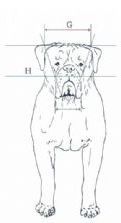
The two sides are angled, but are not parallel. The trapezoid shape should be apparent from both above and in front of the Dogue.
The back skull should be broad and slightly convex from one side to the other with ears set on high at this level to accentuate the width.
The pictures below show Dogues with excellent trapezoid shaped heads.
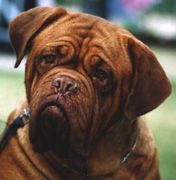
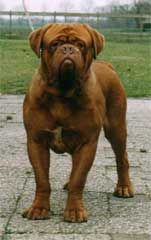
If the head shape is incorrect, it is more likely to resemble either a rectangle or a soccer ball. In comparison with the correct shape above, you can clearly see the incorrect round shape of the head pictured below.
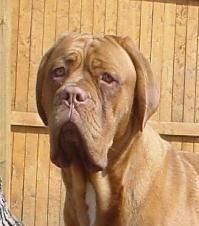
To note the importance of skull shape and profile – square with parallel planes belongs to the Bullmastiff, the Neapolitan and the Mastiff with the Mastiff having a quite curved longitudinal axis, the Neapolitan requiring flatness. All three of these breeds require a muzzle to skull ratio of 1:2 making the Dogue slightly shorter and the Dogue is the only Mastiff breed requiring somewhat ‘closed’ angles in profile.
The trapezoid shaped head is one of the most important aspects of breed type and it is one that the Breed Club in France is putting much emphasis on.
Stop, brows and forehead
The stop is very pronounced, brows are well developed and the frontal groove is deep, diminishing towards the back of the skull.
The forehead dominates the face but is never higher than it is wide.
Wrinkle
The forehead has a distinct symmetrical wrinkle pattern evident, but these wrinkles while deep, must remain mobile. If they are immobile, then the head appears too wet.
The muzzle has moderate folds, we do not want to see thick, deep fleshy folds on the muzzle as seen on the Bulldog.
There should not be fleshy wrinkle filling up under the eye (some chiselling under the eye is desirable). Also to be avoided is the deep wrinkle running from the outside of the eye down the cheek and to the flew. (This is a characteristic of the Neapolitan Mastiff.)
There is a movement towards a somewhat lesser wrinkled, cleaner head at this time to avoid the comparison with the Mastino.
The Muzzle
The Standard says ideal length is somewhere between 1/3 and 1/4 of the total length of the head, from the nose to the occipital crest. In reality, 1/3 is too long and ¼ is too short, so as mentioned, the ideal is somewhere in between. It is powerful and broad, approximately 2/3 the perimeter of the skull, with its width hardly decreasing towards the tip of the muzzle. There should be a great deal of strength to the muzzle. When viewed from above it has the shape of a square.
The upper profile is very slightly concave (dished), although this may be obscured by the wrinkle on mature dogs.
The nose is set back (or the end of the muzzle is in front of the forward edge of the nose).
Nostrils should be well opened and pigment is in accordance with the colour of the mask.
With regard to the pictures below, you can clearly see the strength of muzzle in the dog on the left. Similarly, you can clearly see the setback of the nose and the concave upper profile of the dog on the right.
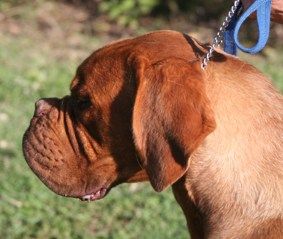
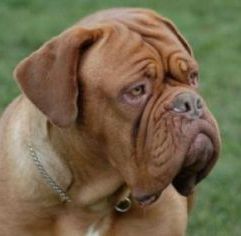
Repandous jaw, undershot mouth and chin mark
The lower jaw of a Dogue de Bordeaux shows a distinct curve upwards (a repandous jaw).
The Dogue must be undershot but the standard gives little measure as to the desired amount. In reality, it can be from 1mm to 2.5cm or more. The undershot coupled with the upwards curve of the jaw has an important role in the appearance of the chin so those dogs with more apparent chins will generally be more undershot.
The chin mark is a very important aspect of type and one that is quickly diminishing in the breed.
If the undershot is not coupled with the repandous (the jaw is flat) then often you have the undesirable situation where canines will show. A large degree of undershot is perfectly acceptable as long as the canines do not show.
Be aware that dogs with a straighter jaw and lesser undershot often have the mouths which appeal to the All-breeds Judge but it is far from the ideal.
The lower lip should be visible at the peak of the reversed, wide V formed by the upper lip.
On the left is a puppy with an good repandous jaw and chin. Whereas on the right is a dog has a flat jaw with insufficient chin.
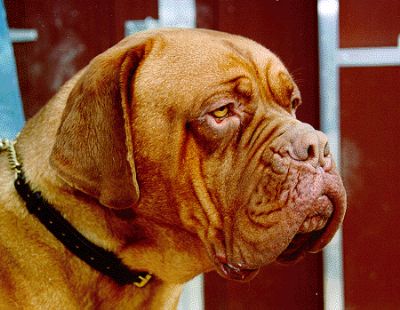
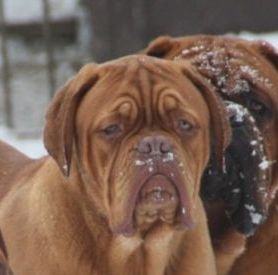
Teeth
Teeth should be strong . The lower canines are set wide apart and curved slightly. Incisors should be in a straight line and should not resemble grains of rice. However in reality, the corner incisors often display a tendency to sideways displacement, sometimes at an angel.
The best way to assess correct prognathism in the Dogue de Bordeaux is to look at the positioning of the upper and lower premolars. In the Dogue, with the shortened upper jaw (undershot), the fourth lower premolar is almost opposite, or even fully opposite, the third upper premolar.
Eye Placement and Colour
The oval shaped eyes are set forward and wide apart, separated by at least two eye spaces. They should be on or above the level of the root of the muzzle, although the correct expression of the Dogue with the slightly higher set nose may give the appearance of the eyes being lower set as it looks over or through the top of the muzzle. This coupled with the chin mark give a defiant and almost arrogant look.
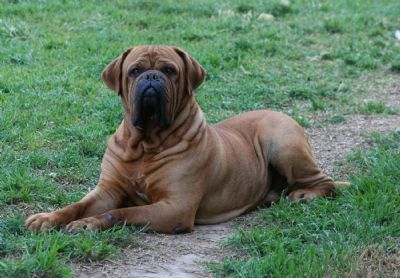
Although the haw should not be visible, reality is sometimes different. Very often the lower lid folds slightly in the middle but isn’t serious in a dog with loose skin.
The eye colour should tone with that of the coat and will be slightly darker in Black mask dogs. Black masked dogs have hazel eyes but at best Dogues with a brown mask have amber coloured eyes.
Lighter coloured eyes tend to detract from the overall expression of the dog.
Ear set
Ears are relatively small, triangular, dropping but firm and reaching to the corner of the eye. (In the Bullmastiff we note the bottom of the ear is ‘level’ with the eye.)
They are set high, at the level of the upper line of the skull and therefore accentuate the width of the skull even more.
In recent times, a number of dogs with ears that are far too high set, sticking up above the skull, are being noticed. The photo of the Dogue below is an example of this.
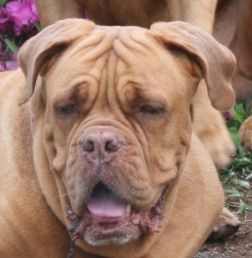
The ears are usually a slightly darker colour than the coat.
The Head in Summary
The trapezoid skull shape, the amount of wrinkle and the degree to which the other aforementioned characteristics are present give rise to the perfectly allowable variation in type seen within the breed. However, it should be noted that the above characteristics relating to the head need to be present for there to be true breed type.
The Body
This page is a work in progress and will be updated with more information.
